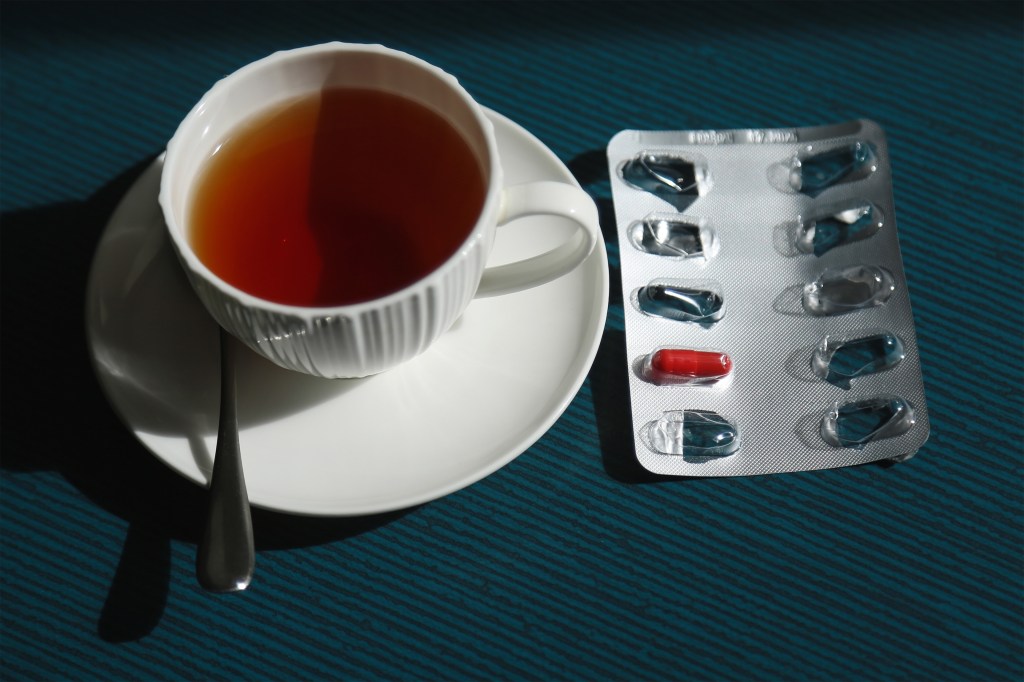Pero no se trataba de una enfermedad misteriosa. Como enfermero anestesista, ya jubilado, Sergott sabía que tenía anemia, una deficiencia de glóbulos rojos. En su caso, era consecuencia de una afección hereditaria por la que tenía hemorragias nasales casi a diario y le bajaba la hemoglobina, la proteína de los glóbulos rojos que transporta oxígeno a todo el cuerpo.
Pero al consultar con los médicos sobre su cansancio, Sergott, quien vive en Westminster, Maryland, descubrió que muchos no sabían cómo ayudarlo. Le aconsejaban que tomara suplementos de hierro, que suele ser la primera línea de tratamiento para la anemia.
Sin embargo, como muchas personas mayores, le resultaba difícil tolerar de cuatro a seis pastillas al día.
Algunos pacientes que toman hierro se quejan de estreñimiento intenso o calambres estomacales. Sergott sentía náuseas todo el tiempo. Y las tabletas de hierro no siempre funcionan.
Después de casi 15 años, encontró una solución. Michael Auerbach, hematólogo y oncólogo, y codirector del Center for Cancer and Blood Disorders en Baltimore, sugirió que Sergott recibiera hierro por vía intravenosa y no por la boca.
Ahora, el hombre de 78 años recibe una infusión de una hora cuando sus niveles de hemoglobina y otros marcadores indican que la necesita, generalmente tres veces al año. “Es como llenar el tanque de gasolina”, dijo. Sus síntomas se revierten y “me siento maravillosamente bien”.
La historia de Sergott refleja una afección común que habitualmente se desestima y que no solo puede lesionar la calidad de vida de los adultos mayores, sino también tener graves consecuencias para la salud, como caídas, fracturas y hospitalizaciones.
Los síntomas de la anemia —cansancio, dolor de cabeza, calambres en las piernas, frío, disminución de la capacidad para hacer ejercicio, confusión mental— a menudo se atribuyen al envejecimiento mismo, afirmó William Ershler, hematólogo e investigador. Más aún porque algunas personas con anemia no presentan síntomas.
“La gente dice: ‘Me siento débil, pero todos los de mi edad se sienten débiles’”, explicó Ershler.
Los médicos a menudo no reconocen la anemia, aunque es probable que los niveles de hemoglobina se incluyen en las historias clínicas de sus pacientes: suele ser parte del hemograma completo que se solicita de manera rutinaria durante las consultas médicas.
“Los pacientes vienen a la clínica, se hacen análisis de sangre y no pasa nada”, dijo.
La anemia afecta al 12,5% de las personas mayores de 60 años, según los datos más recientes de la National Health and Nutrition Examination Survey, y la tasa aumenta a partir de esa edad.
Pero esta cifra podría ser una subestimación.
En un estudio publicado en el Journal of the American Geriatrics Society, Ershler y sus colegas examinaron las historias clínicas electrónicas de casi 2.000 pacientes ambulatorios mayores de 65 años de Inova, el gran sistema de salud con sede en el norte de Virginia, del que se jubiló recientemente.
Según los resultados de los análisis de sangre, la prevalencia de anemia fue mucho mayor: aproximadamente uno de cada 5 pacientes presentaba anemia, con niveles de hemoglobina por debajo de lo normal, según la definición de la Organización Mundial de la Salud (OMS).
Sin embargo, solo alrededor de un tercio de esos pacientes tenían la anemia debidamente documentada en sus historias médicas.
La anemia “merece nuestra atención, pero no siempre la recibe”, afirmó George Kuchel, geriatra de la Universidad de Connecticut, quien no se sorprendió por los hallazgos.
Esto se debe en parte a que la anemia tiene muchas causas, algunas más tratables que otras. En quizás un tercio de los casos, se debe a una deficiencia nutricional, generalmente falta de hierro, pero a veces de vitamina B12 o folato (llamado ácido fólico en forma sintética).
Las personas mayores pueden tener menos apetito o dificultades para comprar alimentos y cocinar. Pero la anemia también puede ser consecuencia de la pérdida de sangre por úlceras, pólipos, diabetes y otras causas de hemorragia interna.
La cirugía también puede provocar deficiencia de hierro. Mary Dagold, de 83 años, bibliotecaria jubilada de Pikesville, Maryland, tuvo tres operaciones abdominales en 2019. Estuvo postrada durante semanas y usó una sonda para alimentarse por meses. Incluso después de recuperarse, “la anemia no desapareció”, contó.
Recuerda que se sentía agotada todo el tiempo. “Y sabía que no estaba pensando como siempre”, agregó. “No podía leer ni una novela”. Tanto su médico de cabecera como Auerbach le advirtieron que era poco probable que las tabletas de hierro la ayudaran.
Estas tabletas, de venta libre, son económicas. El hierro intravenoso, que se receta cada vez con más frecuencia, puede costar entre $350 y $2.400 por infusión, dependiendo de la formulación, explicó Auerbach.
Para algunos pacientes una sola dosis es suficiente, mientras que otros necesitarán un tratamiento regular. Medicare lo cubre cuando las tabletas son difíciles de tolerar o ineficaces.
Para Dagold, una infusión intravenosa de hierro de 25 minutos cada unas cinco semanas ha marcado una diferencia sorprendente. “Tarda unos días, y luego te sientes lo suficientemente bien como para retomar tu vida diaria”, dijo. Ha regresado a su clase de aeróbic acuático cuatro días a la semana.
En otros casos, la anemia se debe a afecciones crónicas como enfermedades cardíacas, insuficiencia renal, trastornos de la médula ósea o afecciones inflamatorias del intestino.
“Estas personas no tienen deficiencia de hierro, pero no pueden procesarlo para producir glóbulos rojos”, explicó Kuchel. Dado que los suplementos de hierro no son efectivos, los médicos intentan abordar la anemia tratando las enfermedades subyacentes.
Otra razón para prestar atención: “La pérdida de hierro puede ser el primer presagio de cáncer de colon y de estómago”, enfatizó Kuchel.
Sin embargo, en cerca de un tercio de los pacientes, la presencia de la anemia es inexplicable. “Hemos hecho todo lo posible y no tenemos idea de qué la causa”, dijo.
Aprender más sobre las causas y los tratamientos de la anemia podría prevenir muchos problemas en el futuro. Además de su asociación con caídas y fracturas, “puede aumentar la gravedad de afecciones crónicas: corazón, pulmón, riñón, hígado”, dijo Auerbach.
“Si es realmente grave y la hemoglobina alcanza niveles potencialmente mortales, puede causar un ataque cardíaco o un derrame cerebral”. Sin embargo, entre las incógnitas se encuentra si el tratamiento temprano de la anemia y el restablecimiento de niveles normales de hemoglobina pueden prevenir afecciones posteriores.
Aun así, “se están logrando avances en este campo”, afirmó Ershler, señalando un taller del Instituto Nacional sobre el Envejecimiento sobre anemia inexplicable realizado el año pasado.
La Sociedad Americana de Hematología ha designado un comité para el diagnóstico y tratamiento de la deficiencia de hierro y planea publicar nuevas directrices el próximo año. El Iron Consortium at Oregon Health & Science University convocó un panel internacional sobre el manejo de la deficiencia de hierro y publicó recientemente sus recomendaciones en The Lancet Haematology.
Mientras tanto, muchos pacientes mayores pueden acceder a sus resultados del hemograma completo y a sus niveles de hemoglobina. La OMS define 13 gramos de hemoglobina por decilitro como normal para los hombres y 12 para las mujeres no embarazadas. (Aunque algunos hematólogos argumentan que estos umbrales son demasiado bajos).
Preguntar a los profesionales de salud sobre los niveles de hemoglobina y hierro, o utilizar un portal para pacientes para consultar las cifras ellos mismos, podría ayudarlos a hablar con sus médicos no solo de la fatiga u otros síntomas como consecuencias inevitables del envejecimiento.
Quizás sean signos de anemia, y quizás sea tratable.
“Lo más probable es que te hayas hecho un hemograma completo en los últimos seis meses o un año”, dijo Kuchel. “Si tu hemoglobina está bien, ¡genial!”.
Pero agregó que “si está realmente fuera de los límites normales o ha cambiado en comparación con el año pasado, debes preguntar”.
La sección The New Old Age se produce a través de una alianza con The New York Times.
KFF Health News is a national newsroom that produces in-depth journalism about health issues and is one of the core operating programs at KFF—an independent source of health policy research, polling, and journalism. Learn more about KFF.
USE OUR CONTENT
This story can be republished for free (details).





